Concentration Optimization of Localized Cu0 and Cu+ on Cu-Based Electrodes for Improving Electrochemical Generation of Ethanol from Carbon Dioxide
Abstract
:1. Introduction
2. Results and Discussion
2.1. Morphology of Cu-Based Electrodes
2.2. The Phase Analysis of Cu-Based Electrodes
2.3. Electrochemical CO2 Reduction for Cu-Based Electrodes
2.4. Electrochemical Characterization of Cu-Based Electrodes
2.5. X-ray Photoelectron Spectroscopy of Cu-Based Materials
2.6. The Formation of *CO Intermadiate for Ethanol Production
3. Materials and Methods
4. Conclusions
Author Contributions
Funding
Institutional Review Board Statement
Informed Consent Statement
Data Availability Statement
Acknowledgments
Conflicts of Interest
References
- Wang, P.; Yang, H.; Xu, Y.; Huang, X.; Wang, J.; Zhong, M.; Cheng, T.; Shao, Q. Synergized Cu/Pb Core/Shell Electrocatalyst for High-Efficiency CO2 Reduction to C2+ Liquids. ACS Nano 2021, 15, 1039. [Google Scholar] [CrossRef] [PubMed]
- Lamaison, S.; Wakerley, D.; Kracke, F.; Moore, T.; Zhou, L.; Lee, D.U.; Wang, L.; Hubert, M.A.; Aviles Acosta, J.E.; Gregoire, J.M.; et al. Designing a Zn-Ag Catalyst Matrix and Electrolyzer System for CO2 Conversion to CO and Beyond. Adv. Mater. 2021, 34, 2103963. [Google Scholar] [CrossRef] [PubMed]
- Xie, H.; Wan, Y.; Wang, X.; Liang, J.; Lu, G.; Wang, T.; Chai, G.; Adli, N.M.; Priest, C.; Huang, Y.; et al. Boosting Pd-Catalysis for Electrochemical CO2 Reduction to CO on Bi-Pd Single Atom Alloy Nanodendrites. Appl. Catal. B 2021, 289, 119783. [Google Scholar] [CrossRef]
- Xue, L.; Zhang, A.; Wu, J.; Wang, Q.; Liu, Y.; Zhao, Y.; Liu, S.; Liu, Z.; Li, P.; Zeng, S. Surface Modification and Reconstruction of ZnO Hollow Microspheres for Selective Electroreduction of CO2 to CO. J. Alloys Compd. 2021, 882, 160703. [Google Scholar] [CrossRef]
- Tian, J.; Wang, R.; Shen, M.; Ma, X.; Yao, H.; Hua, Z.; Zhang, L. Bi-Sn Oxides for Highly Selective CO2 Electroreduction to Formate in a Wide Potential Window. ChemSusChem 2021, 14, 2247. [Google Scholar] [CrossRef]
- Mohamed, A.G.A.; Zhou, E.; Zeng, Z.; Xie, J.; Gao, D.; Wang, Y. Asymmetric Oxo-Bridged ZnPb Bimetallic Electrocatalysis Boosting CO2-to-HCOOH Reduction. Adv. Sci. 2021, 9, 2104138. [Google Scholar] [CrossRef]
- Huang, M.; Gong, S.; Wang, C.; Yang, Y.; Jiang, P.; Wang, P.; Hu, L.; Chen, Q. Lewis-Basic EDTA as a Highly Active Molecular Electrocatalyst for CO2 Reduction to CH4. Angew. Chem. Int. Ed. 2021, 60, 23002. [Google Scholar] [CrossRef]
- Lu, L.; Sun, X.; Ma, J.; Yang, D.; Wu, H.; Zhang, B.; Zhang, J.; Han, B. Highly Efficient Electroreduction of CO2 to Methanol on Palladium-Copper Bimetallic Aerogels. Angew. Chem. Int. Ed. 2018, 57, 14149. [Google Scholar] [CrossRef]
- Lu, Y.F.; Dong, L.Z.; Liu, J.; Yang, R.X.; Liu, J.J.; Zhang, Y.; Zhang, L.; Wang, Y.R.; Li, S.L.; Lan, Y.Q. Predesign of Catalytically Active Sites via Stable Coordination Cluster Model System for Electroreduction of CO2 to Ethylene. Angew. Chem. Int. Ed. 2021, 60, 26210. [Google Scholar] [CrossRef]
- Aran-Ais, R.M.; Scholten, F.; Kunze, S.; Rizo, R.; Cuenya, B.R. The Role of In Situ Generated Morphological Motifs and Cu(I) Species in C2+ Product Selectivity During CO2 Pulsed Electroreduction. Nat. Energy 2020, 5, 317. [Google Scholar] [CrossRef]
- Fan, Q.; Zhang, X.; Ge, X.; Bai, L.; He, D.; Qu, Y.; Kong, C.; Bi, J.; Ding, D.; Cao, Y.; et al. Manipulating Cu Nanoparticle Surface Oxidation States Tunes Catalytic Selectivity toward CH4 or C2+ Products in CO2 Electroreduction. Adv. Energy Mater. 2021, 11, 2101424. [Google Scholar] [CrossRef]
- Kim, C.; Cho, K.M.; Park, K.; Kim, J.Y.; Yun, G.T.; Toma, F.M.; Gereige, I.; Jung, H.T. Cu/Cu2O Interconnected Porous Aerogel Catalyst for Highly Productive Electrosynthesis of Ethanol from CO2. Adv. Funct. Mater. 2021, 31, 2102142. [Google Scholar] [CrossRef]
- Wang, J.; Yang, H.; Liu, Q.; Liu, Q.; Li, X.; Lv, X.; Cheng, T.; Wu, H.B. Fastening Br- Ions at Copper-Molecule Interface Enables Highly Efficient Electroreduction of CO2 to Ethanol. ACS Energy Lett. 2021, 6, 437. [Google Scholar] [CrossRef]
- Ebaid, M.; Jiang, K.; Zhang, Z.; Drisdell, W.S.; Bell, A.T.; Cooper, J.K. Production of C2/C3 Oxygenates from Planar Copper Nitride-Derived Mesoporous Copper via Electrochemical Reduction of CO2. Chem. Mater. 2020, 32, 3304. [Google Scholar] [CrossRef]
- Gao, D.; Aran-Ais, R.M.; Jeon, H.; Cuenya, B. Rational Catalyst and Electrolyte Design for CO2 Electroreduction towards Multicarbon Products. Nat. Catal. 2019, 2, 198. [Google Scholar] [CrossRef]
- Mosali, V.S.S.; Zhang, X.; Liang, Y.; Li, L.; Puxty, G.; Horne, M.D.; Brajter-Toth, A.; Bond, A.M.; Zhang, J. CdS-Enhanced Ethanol Selectivity in Electrocatalytic CO2 Reduction at Sulfide-Derived Cu-Cd. ChemSusChem 2021, 14, 2924. [Google Scholar] [CrossRef] [PubMed]
- Lei, Q.; Zhu, H.; Song, K.; Wei, N.; Liu, L.; Zhang, D.; Yin, J.; Dong, X.; Yao, K.; Wang, N.; et al. Investigating the Origin of Enhanced C2+ Selectivity in Oxide-/Hydroxide-Derived Copper Electrodes during CO2 Electroreduction. J. Am. Chem. Soc. 2020, 142, 4213. [Google Scholar] [CrossRef]
- Iyengar, P.; Kolb, M.J.; Pankhurst, J.R.; Calle-Vallejo, F.; Buonsanti, R. Elucidating the Facet-Dependent Selectivity for CO2 Electroreduction to Ethanol of Cu-Ag Tandem Catalysts. ACS Catal. 2021, 11, 4456. [Google Scholar] [CrossRef]
- Garza, A.J.; Bell, A.T.; Head-Gordon, M. Mechanism of CO2 Reduction at Copper Surfaces: Pathways to C2 Products. ACS Catal. 2018, 8, 1490. [Google Scholar] [CrossRef]
- Cheng, T.; Xiao, H.; Goddard III, W.A. Reaction Mechanisms for the Electrochemical Reduction of CO2 to CO and Formate on the Cu(100) Surface at 298 K from Quantum Mechanics Free Energy Calculations with Explicit Water. J. Am. Chem. Soc. 2016, 138, 13802. [Google Scholar] [CrossRef]
- Zheng, Y.; Vasileff, A.; Zhou, X.; Jiao, Y.; Jaroniec, M.; Qiao, S.Z. Understanding the Roadmap for Electrochemical Reduction of CO2 to Multi-Carbon Oxygenates and Hydrocarbons on Copper-Based Catalysts. J. Am. Chem. Soc. 2019, 141, 7646. [Google Scholar] [CrossRef] [PubMed]
- Montoya, J.H.; Peterson, A.A.; Nørskov, J.K. Insights into C-C Coupling in CO2 Electroreduction on Copper Electrodes. ChemCatChem 2013, 5, 737. [Google Scholar] [CrossRef]
- Bai, X.; Li, Q.; Shi, L.; Niu, X.; Ling, C.; Wang, J. Hybrid Cu0 and Cux+ as Atomic Interfaces Promote High-Selectivity Conversion of CO2 to C2H5OH at Low Potential. Small 2020, 16, 1901981. [Google Scholar] [CrossRef] [PubMed]
- Scholten, F.; Sinev, I.; Bernal, M.; Cuenya, B.R. Plasma-modified Dendritic Cu Catalyst for CO2 Electroreduction. ACS Catal. 2019, 9, 5496. [Google Scholar] [CrossRef]
- Xiao, H.; Goddard III, W.A.; Cheng, T.; Liu, Y. Cu Metal Embedded in Oxidized Matrix Catalyst to Promote CO2 Activation and CO Dimerization for Electrochemical Reduction of CO2. Proc. Natl. Acad. Sci. USA 2017, 114, 6685. [Google Scholar] [CrossRef]
- Shang, L.; Lv, X.; Shen, H.; Shao, Z.; Zheng, G. Selective Carbon Dioxide Electroreduction to Ethylene and Ethanol by Core-Shell Copper/Cuprous Oxide. J. Colloid Interface Sci. 2019, 552, 426. [Google Scholar] [CrossRef]
- Yang, Q.; Liu, X.; Peng, W.; Zhao, Y.; Liu, Z.; Peng, M.; Lu, Y.R.; Chan, T.S.; Xu, X.; Tan, Y. Vanadium Oxide Integrated on Hierarchically Nanoporous Copper for Efficient Electroreduction of CO2 to Ethanol. J. Mater. Chem. A 2021, 9, 3044. [Google Scholar] [CrossRef]
- Wu, X.; Fan, H.; Sharif, M.; Yu, Y.; Wei, K.; Zhang, A.; Liu, G. Electrochemically-mediated Amine Regeneration of CO2 Capture: From Electrochemical Mechanism to Bench-scale Visualization Study. Appl. Energy 2021, 302, 117553. [Google Scholar] [CrossRef]
- Zhang, L.; Li, M.; Zhang, S.; Cao, X.; Bo, J.; Zhu, X.; Han, J.; Ge, Q.; Wang, H. Promoting Carbon Dioxide Electroreduction Toward Ethanol Through Loading Au Nanoparticles on Hollow Cu2O Nanospheres. Catal. Today 2021, 365, 348. [Google Scholar] [CrossRef]
- Liu, P.; Hensen, E.J.M. Highly Efficient and Robust Au/MgCuCr2O4 Catalyst for Gas-Phase Oxidation of Ethanol to Acetaldehyde. J. Am. Chem. Soc. 2013, 135, 14032. [Google Scholar] [CrossRef]
- Platzman, I.; Brener, R.; Haick, R.; Tannenbaum, H. Oxidation of Polycrystalline Copper Thin Films at Ambient Conditions. J. Phys. Chem. C 2008, 112, 1101. [Google Scholar] [CrossRef]
- Liu, J.; Fu, J.; Zhou, Y.; Zhu, W.; Jiang, L.P.; Lin, Y. Controlled Synthesis of EDTA-Modified Porous Hollow Copper Microspheres for High-Efficiency Conversion of CO2 to Multicarbon Products. Nano Lett. 2020, 20, 4823. [Google Scholar] [CrossRef] [PubMed]
- Ding, L.; Han, Q.; Lu, H.; Yang, Y.; Lu, G.; Zhang, H.; Ran, X.; Xia, Y.; Li, P.; Chen, Y.; et al. Valence Regulation of Ultrathin Cerium Vanadate Nanosheets for Enhanced Photocatalytic CO2 Reduction to CO. Catalysts 2021, 11, 1115. [Google Scholar] [CrossRef]
- Kim, J.Y.; Park, W.; Choi, C.; Kim, G.; Cho, K.M.; Lim, J.; Kim, S.J.; Al-Saggaf, A.; Gereige, I.; Lee, H.; et al. High Facets on Nanowrinkled Cu via Chemical Vapor Deposition Graphene Growth for Efficient CO2 Reduction into Ethanol. ACS Catal. 2021, 11, 5658. [Google Scholar] [CrossRef]
- Liu, X.; Xiao, J.; Peng, H.; Hong, X.; Chan, K.; Norskov, J.K. Understanding Trends in Electrochemical Carbon Dioxide Reduction Rates. Nat. Commun. 2017, 8, 15438. [Google Scholar] [CrossRef]
- Kresse, G.; Furthmuller, J. Efficiency of Ab-Initio Total Energy Calculations for Metals and Semiconductors using a Plane-Wave Basis Set. Comput. Mater. Sci. 1996, 6, 15. [Google Scholar] [CrossRef]
- Kresse, G.; Furthmuller, J. Efficient Iterative Schemes for Ab Initio Total-Energy Calculations using a Plane-Wave Basis Set. Phys. Rev. B 1996, 54, 11169. [Google Scholar] [CrossRef]
- Perdew, J.P.; Burke, K.; Ernzerhof, M. Generalized Gradient Approximation Made Simple. Phys. Rev. Lett. 1997, 78, 1396. [Google Scholar] [CrossRef]
- Kresse, G.; Joubert, D. From Ultrasoft Pseudopotentials to the Projector Augmented-Wave Method. Phys. Rev. B 1999, 59, 1758. [Google Scholar] [CrossRef]
- Blochl, P.E. Projector Augmented-Wave Method. Phys. Rev. B 1994, 50, 17953. [Google Scholar] [CrossRef]
- Grimme, S.; Antony, J.; Ehrlich, S.; Krieg, H. A Consistent and Accurate Ab Initio Parametrization of Density Functional Dispersion Correction (DFT-D) for the 94 Elements H-Pu. J. Chem. Phys. 2010, 132, 154104. [Google Scholar] [CrossRef] [PubMed]
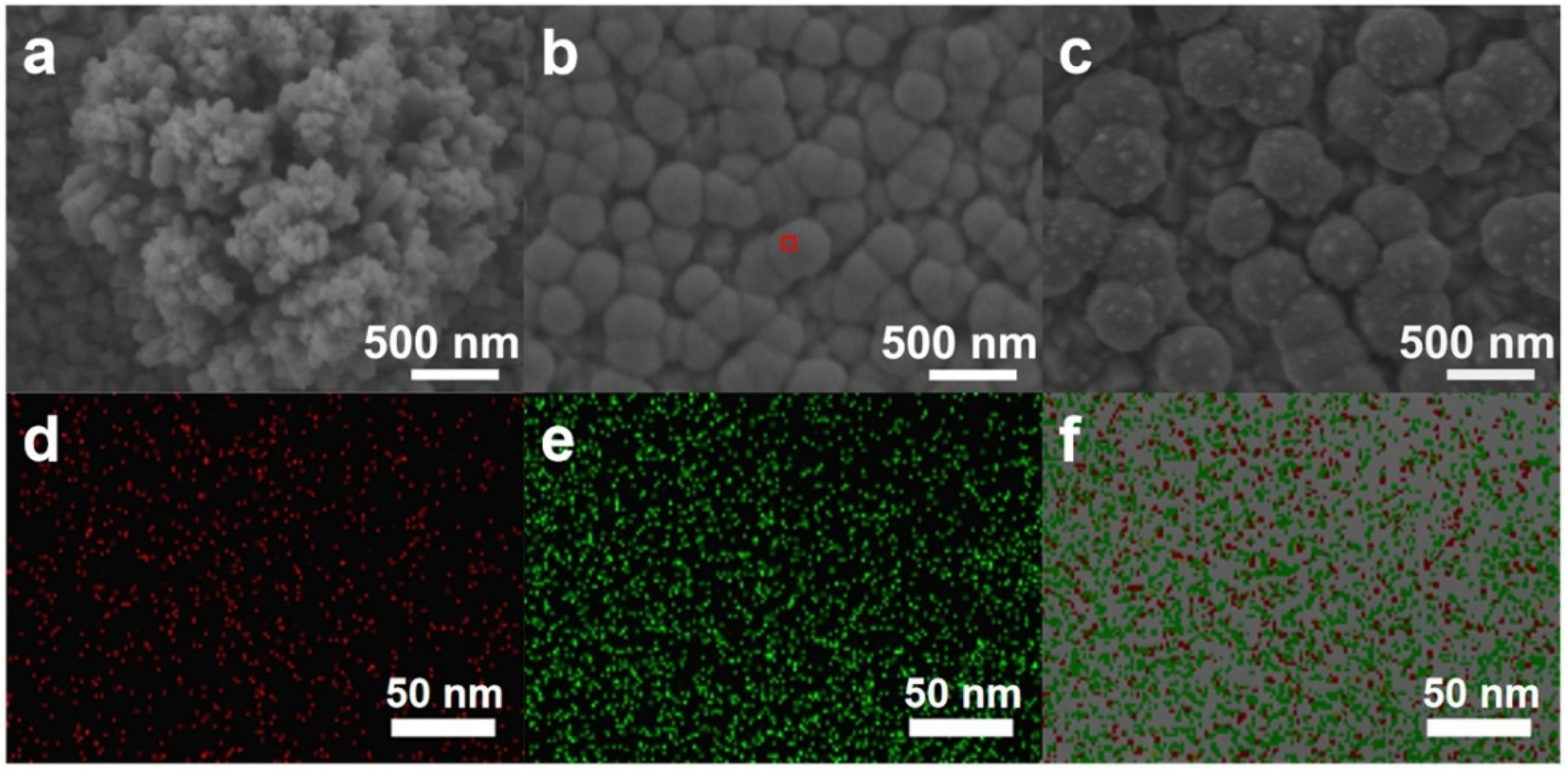
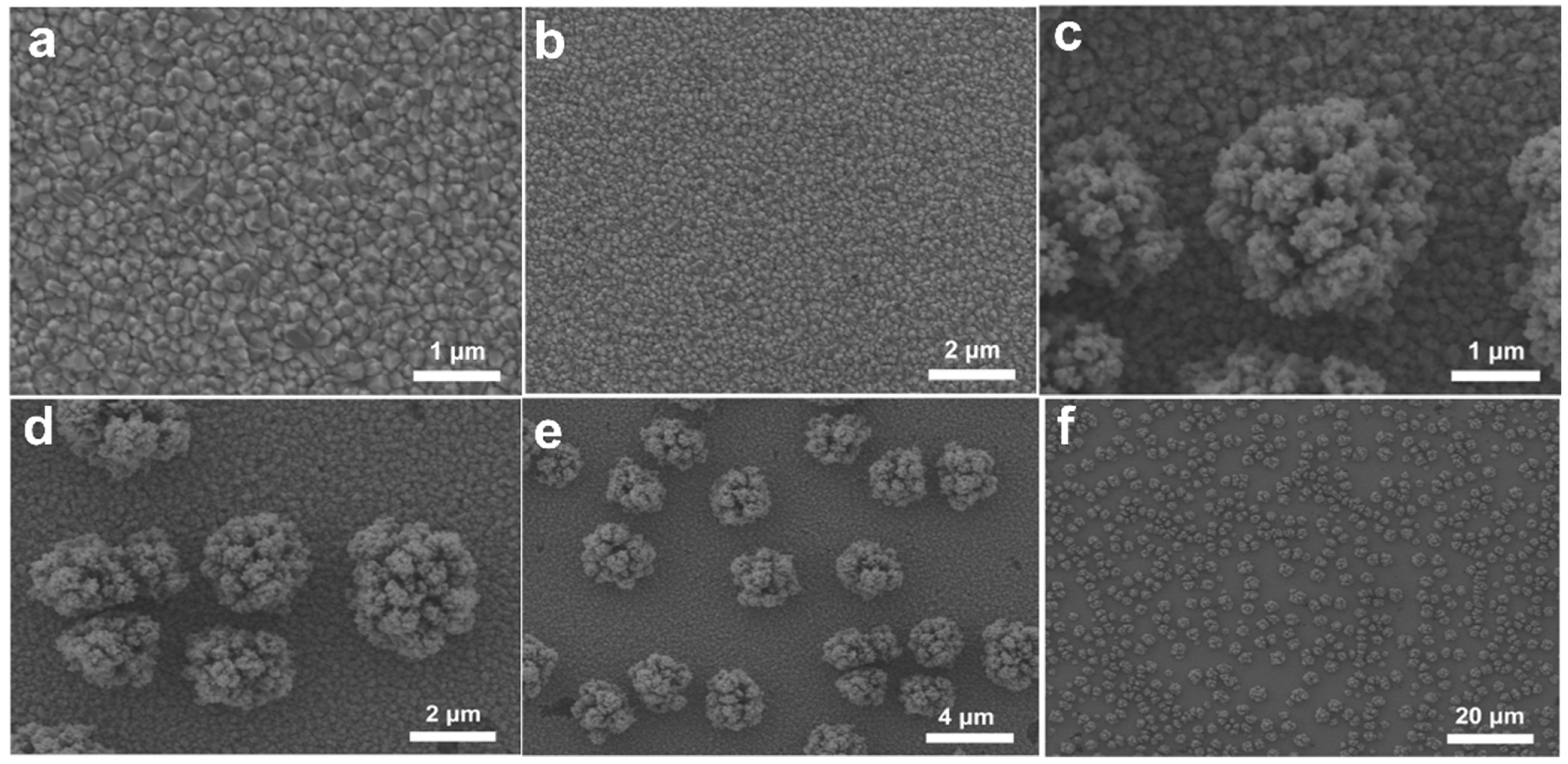
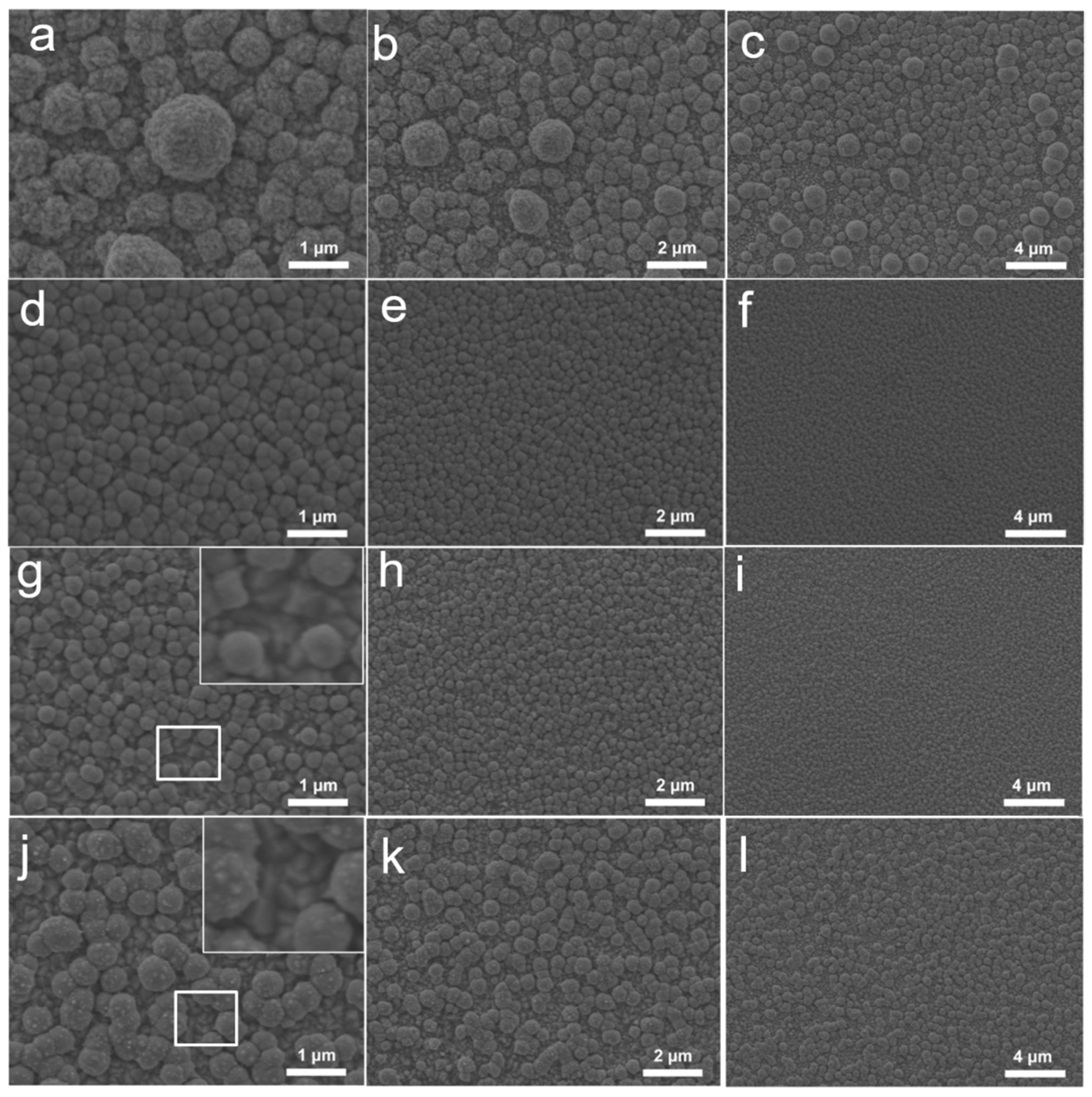


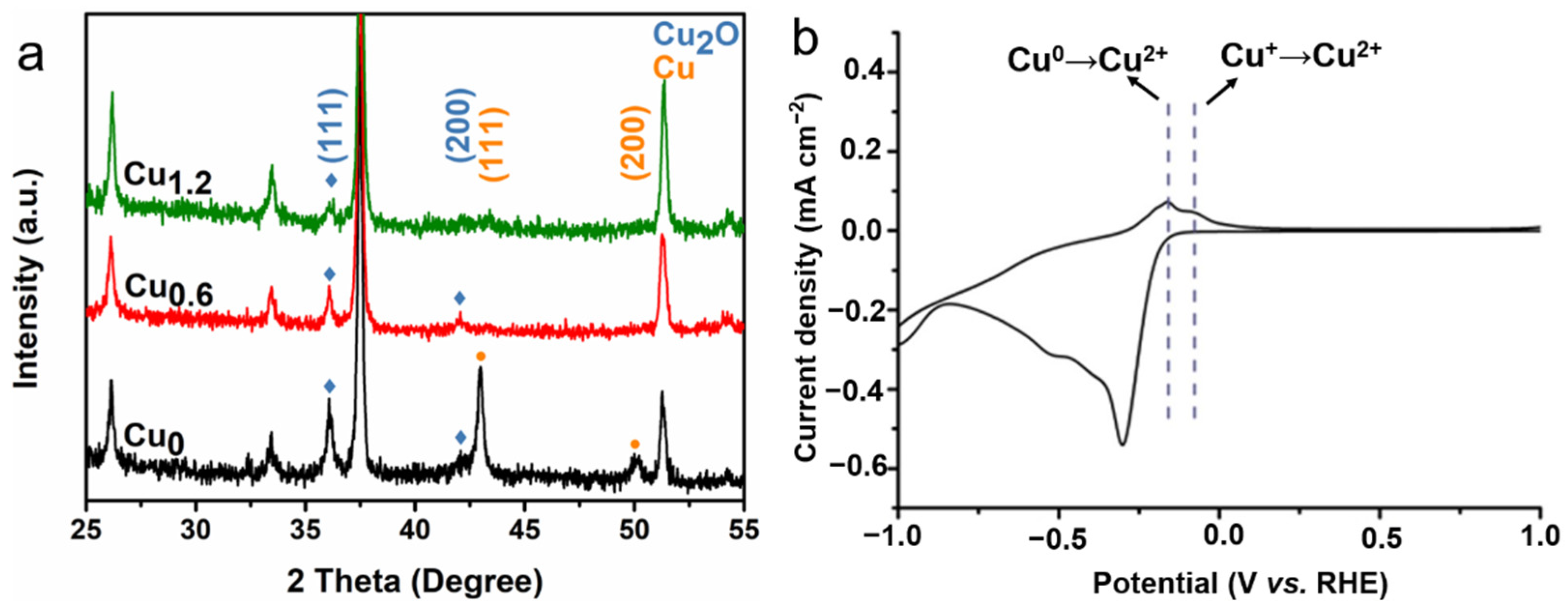

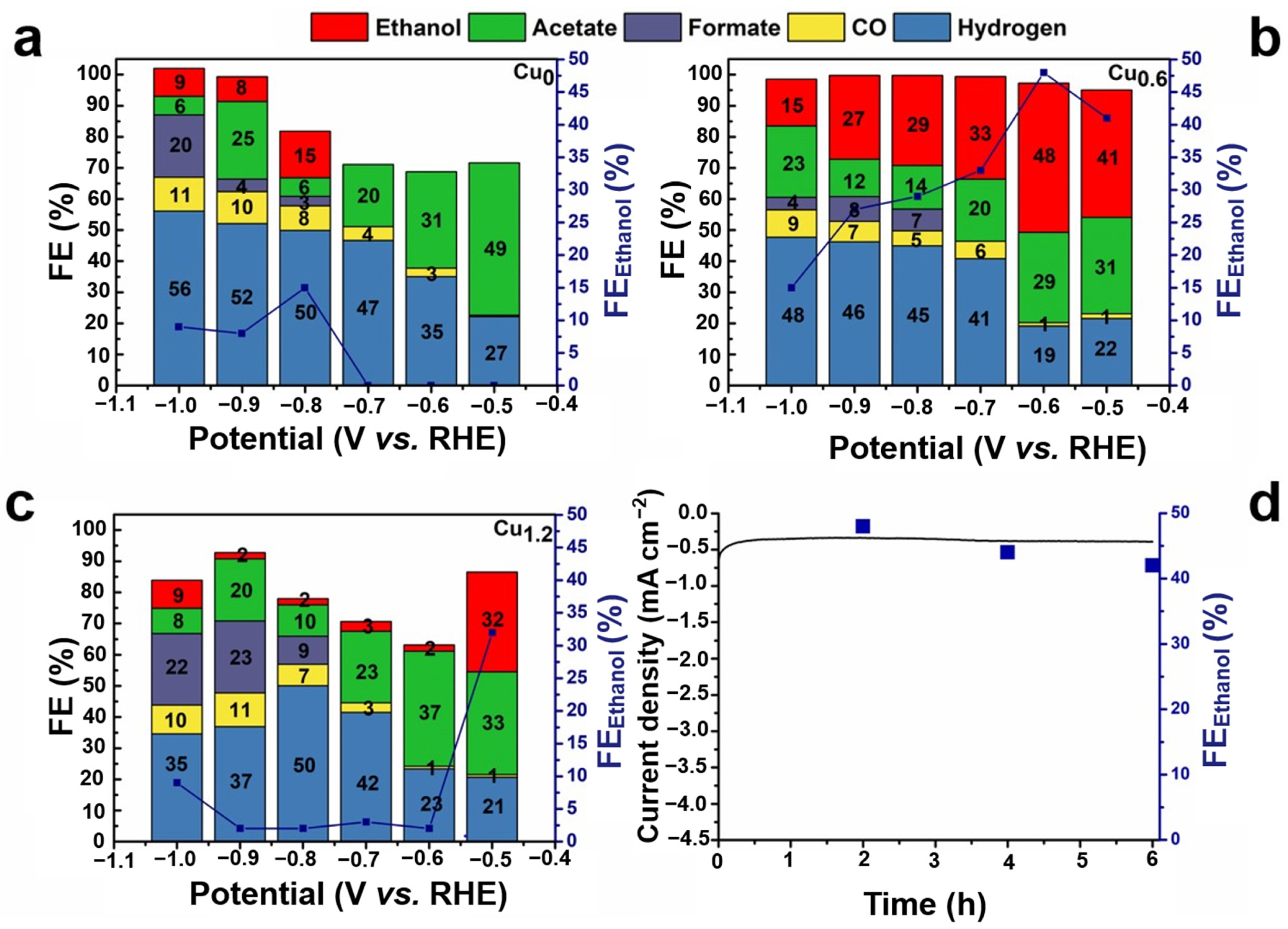
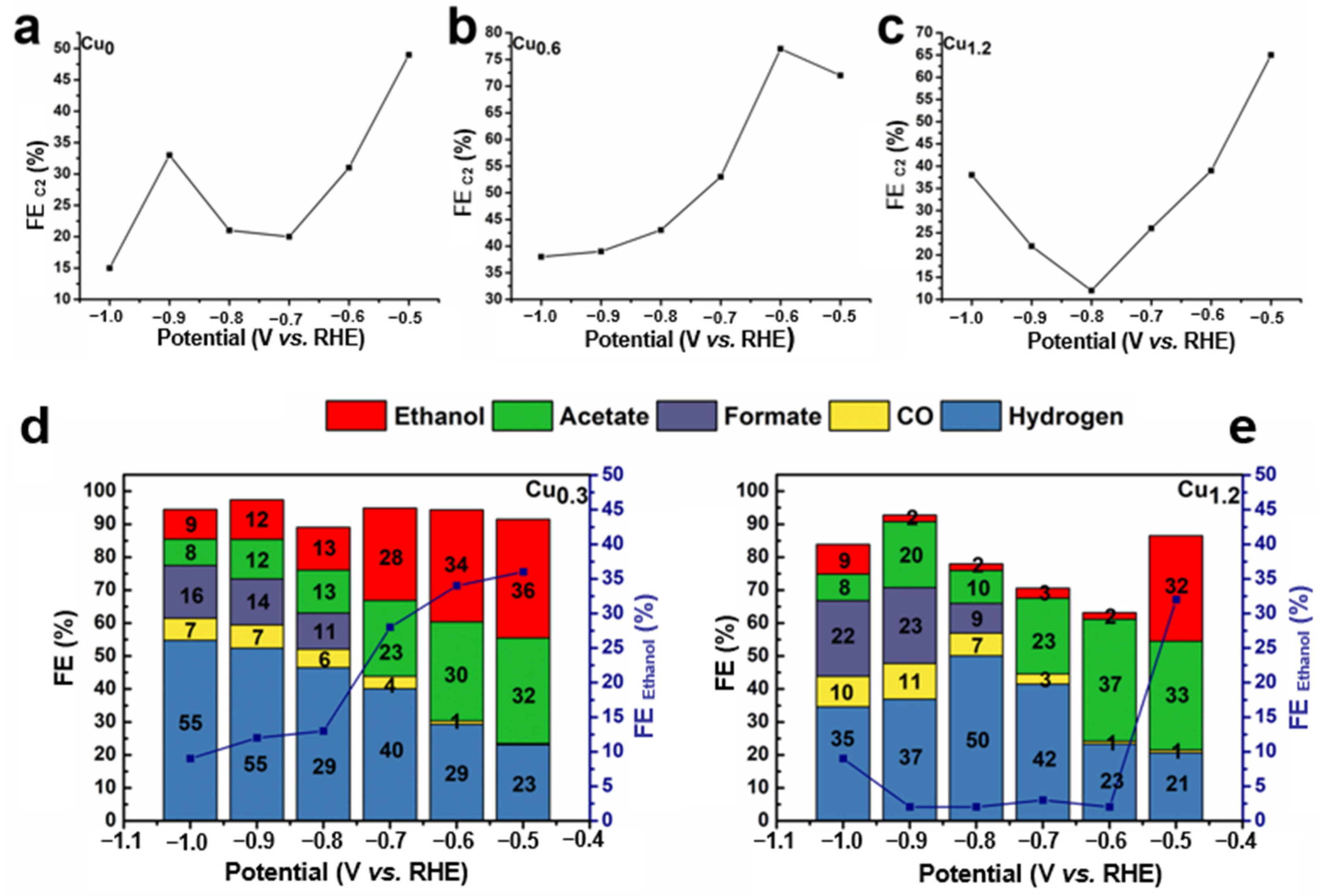
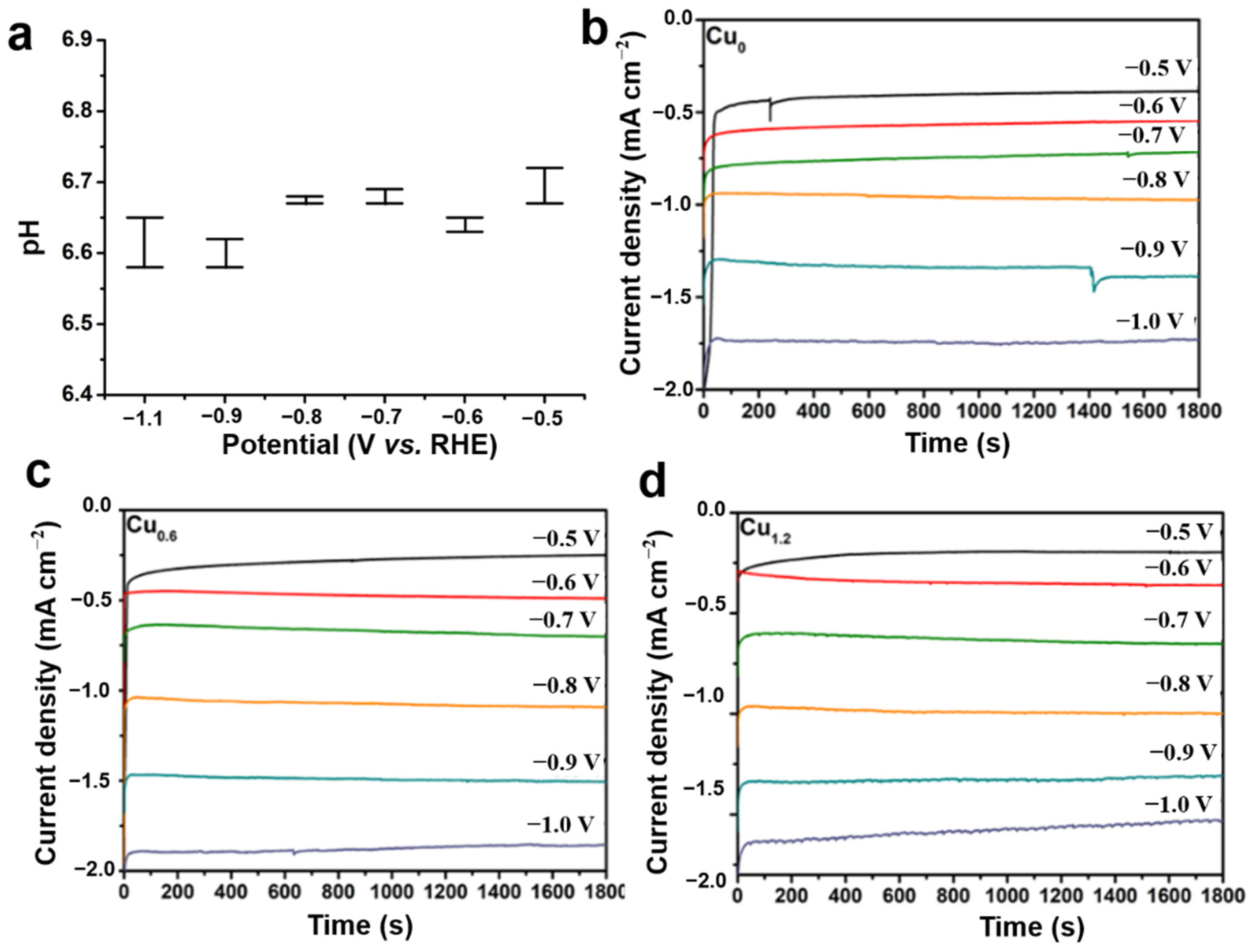
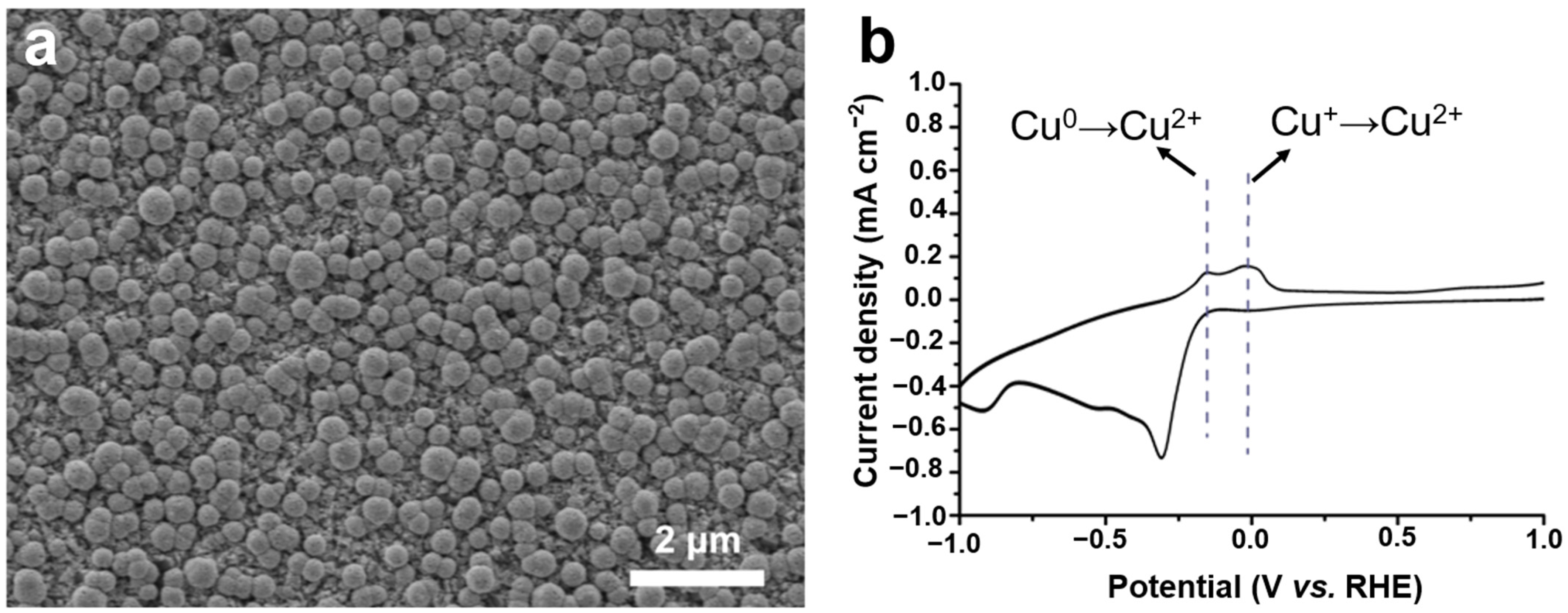

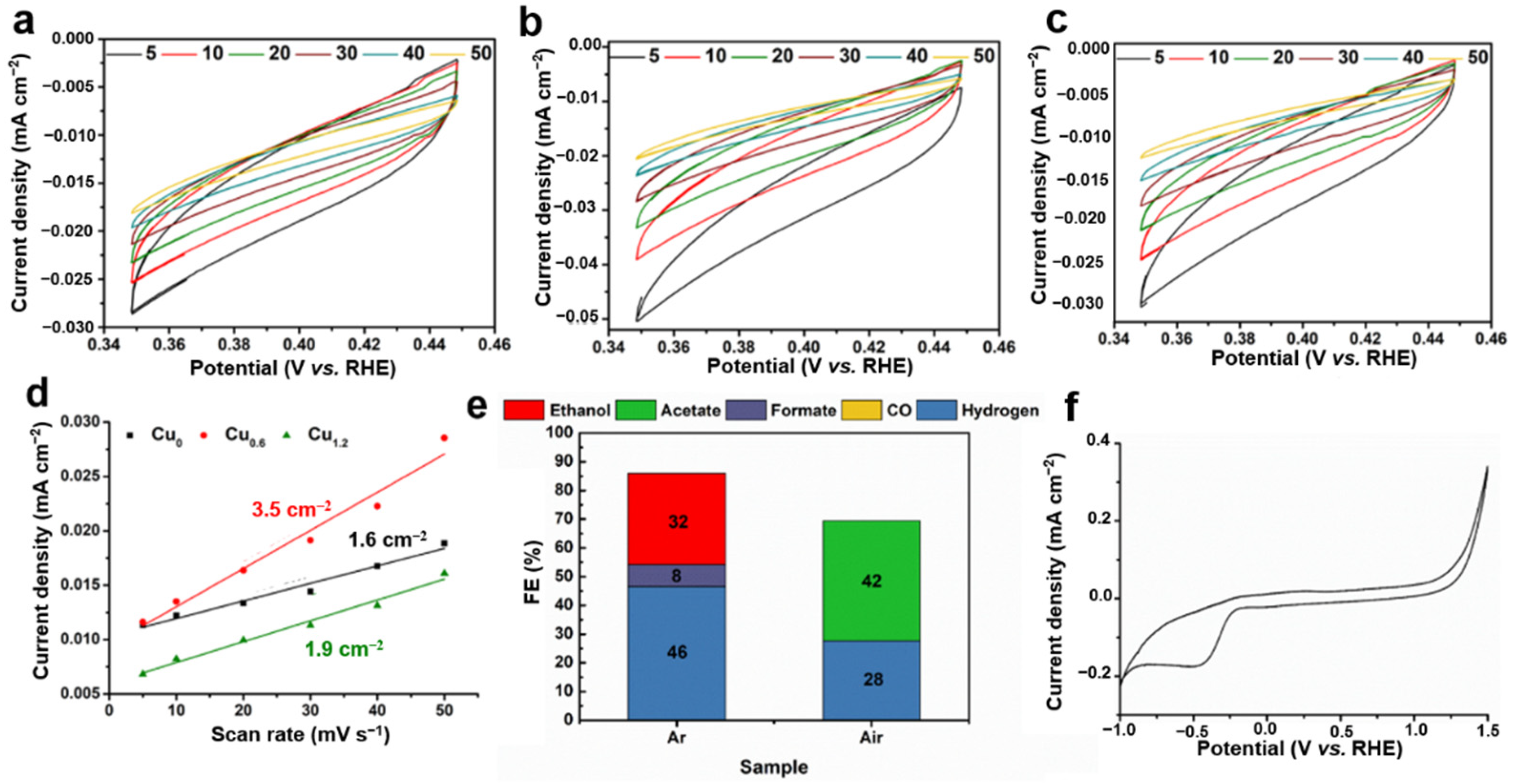

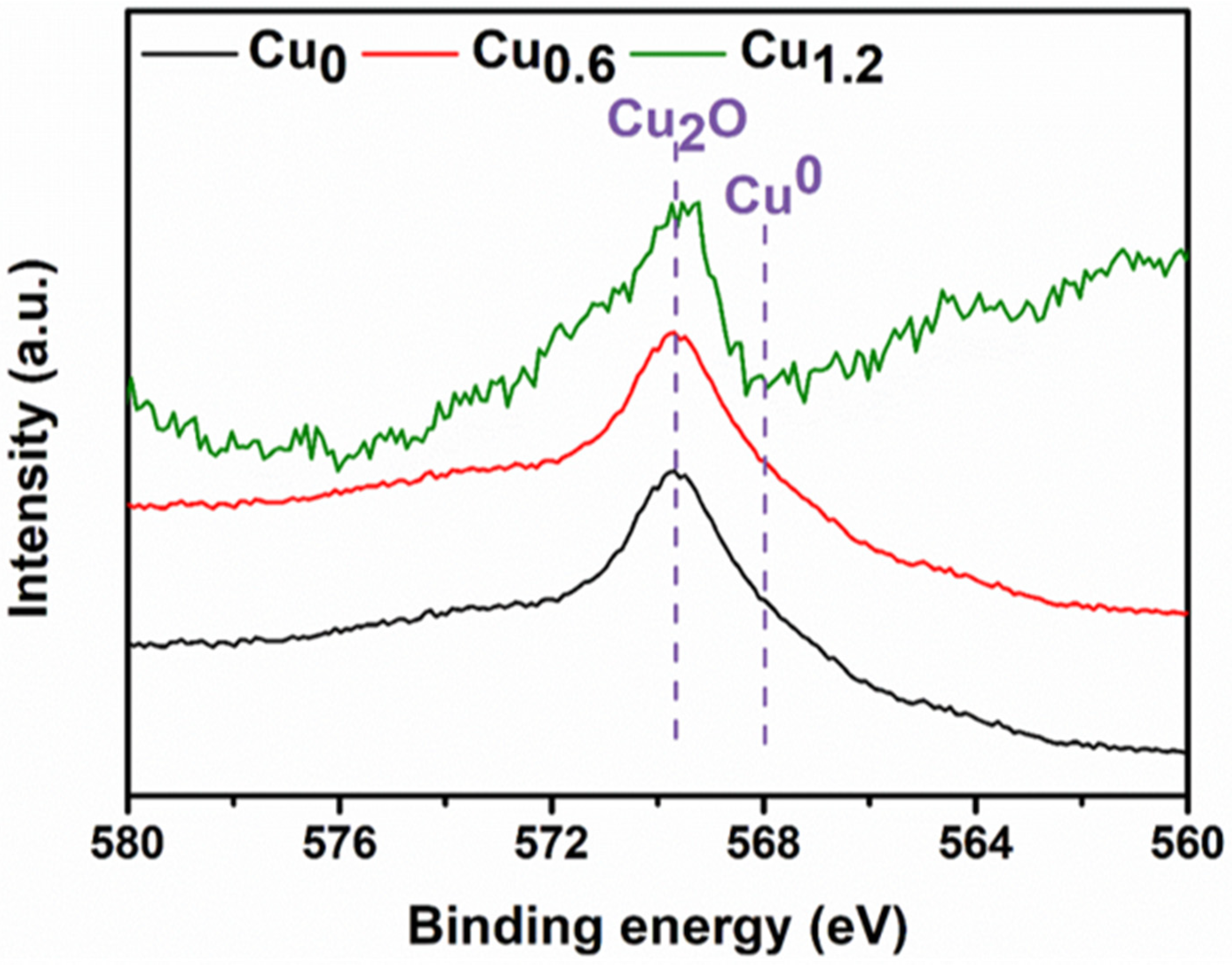



| Catalyst | Electrolyte | FE (Ethanol)/% | FE (C2)/% | Ref. |
|---|---|---|---|---|
| Cu/Cu2O | 0.1 M KCl | 41.2% | 81% | [12] |
| CuBr-DDT | 0.5 M KCl | 35.9% | 72% | [13] |
| Cu/Cu2O-Ag-0.6 | 0.1 M KHCO3 | 19.2% | 60.9% | [16] |
| SD-CuCd2 | 0.1 M KHCO3 | 32% | - | [17] |
| Cuoh-Ag | 0.1 M KHCO3 | 23.1% | 36.9% | [18] |
| Cu@Cu2O | 0.1 M KHCO3 | 29% | 50% | [25] |
| np-Cu@VO2-5% | 0.1 M KHCO3 | 30.1% | - | [26] |
| Au0.17/Cu2O | 0.1 M KHCO3 | 16.2% | - | [27] |
| Cu0.6 | 0.1 M KHCO3 | 48% | 77% | our work |
Publisher’s Note: MDPI stays neutral with regard to jurisdictional claims in published maps and institutional affiliations. |
© 2022 by the authors. Licensee MDPI, Basel, Switzerland. This article is an open access article distributed under the terms and conditions of the Creative Commons Attribution (CC BY) license (https://creativecommons.org/licenses/by/4.0/).
Share and Cite
Lu, H.; Wang, G.; Zhou, Y.; Wotango, A.S.; Wu, J.; Meng, Q.; Li, P. Concentration Optimization of Localized Cu0 and Cu+ on Cu-Based Electrodes for Improving Electrochemical Generation of Ethanol from Carbon Dioxide. Int. J. Mol. Sci. 2022, 23, 9373. https://doi.org/10.3390/ijms23169373
Lu H, Wang G, Zhou Y, Wotango AS, Wu J, Meng Q, Li P. Concentration Optimization of Localized Cu0 and Cu+ on Cu-Based Electrodes for Improving Electrochemical Generation of Ethanol from Carbon Dioxide. International Journal of Molecular Sciences. 2022; 23(16):9373. https://doi.org/10.3390/ijms23169373
Chicago/Turabian StyleLu, Hong, Guan Wang, Yong Zhou, Aselefech Sorsa Wotango, Jiahao Wu, Qi Meng, and Ping Li. 2022. "Concentration Optimization of Localized Cu0 and Cu+ on Cu-Based Electrodes for Improving Electrochemical Generation of Ethanol from Carbon Dioxide" International Journal of Molecular Sciences 23, no. 16: 9373. https://doi.org/10.3390/ijms23169373
APA StyleLu, H., Wang, G., Zhou, Y., Wotango, A. S., Wu, J., Meng, Q., & Li, P. (2022). Concentration Optimization of Localized Cu0 and Cu+ on Cu-Based Electrodes for Improving Electrochemical Generation of Ethanol from Carbon Dioxide. International Journal of Molecular Sciences, 23(16), 9373. https://doi.org/10.3390/ijms23169373






